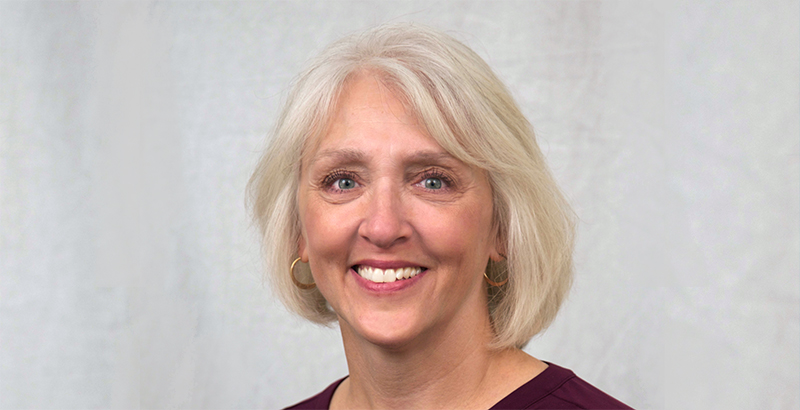74 Interview: National Student Clearinghouse’s Michele Gralak on Helping Schools and Districts Put Data to Work for Their Kids

See previous 74 interviews: Sen. Cory Booker talks about the success of Newark’s school reforms, civil rights activist Dr. Howard Fuller talks confronting Elizabeth Warren on charter schools, criminologist Nadine Connell talks about the data behind school shootings, former U.S. Department of Education secretary John King talks the Trump administration and more. The full archive is right here.
School districts in high-income neighborhoods assume that almost all their graduates will succeed in college. But often, their alumni fall short of expectations. Districts serving students in low-income neighborhoods cite their success in enrolling more students in college. But the number of their students who actually persist to earn degrees can be dismayingly low as well.
The only way for any school district to learn about actual college graduation rates for their alumni, and take steps to boost those rates, is to gather the data. And there’s only one source for that data: the National Student Clearinghouse, a nonprofit located in Herndon, Virginia.
Michele Gralak, a senior business analyst for the clearinghouse who works with K-12 schools, spoke with The 74 about the data they collect and the various ways schools use the information to help their students. This interview has been edited for length and clarity.
The 74: What does the Clearinghouse offer high schools?
Gralak: We can give them college enrollment and college degrees earned for their graduates. The schools give us their student data, including names and dates of birth, and we match that against our database supplied by colleges and universities. We let them know whether their graduates were continuously enrolled or stopped out. If they graduated from college, we can tell them where they graduated from, the state it’s in, whether it’s a two- or four-year college and whether it was a public or private college.
A counselor or principal can find out if a student enrolled in the first year after graduation or the second year. And then the big key is persistence. Did they make it all the way through college to earn a degree? Our reports give educators data on outcomes eight years after leaving high school. Educators can also use the data to evaluate changes they made to their K-12 programming — did those changes boost college enrollment and persistence?
Do K-12 districts have any other source for this data?
No.
Doesn’t the federal Integrated Postsecondary Education Data System give high school college counselors all the information they need to know about colleges, including their graduation rates?
IPEDS is a valuable resource about colleges. What the Clearinghouse tells K-12 educators is how their own students fared in college. For example, a college’s overall average graduation rate you see in IPEDS may be far higher or lower than the graduation rates for the students from your high school.
How much does it cost per year to get eight years of data on a school’s graduates?
$425 per school. It’s very low, and that speaks to our nonprofit status.
Many people think the Clearinghouse is more about tracking student loans than tracking student outcomes.
That goes back to the reason we were created 26 years ago: to help the student loan community. It was a way the loan servicers, lenders and U.S. Department of Education could all know the current status of students — who could defer their loan payments, be eligible for more loans, or if they had to start repaying the loan. But today, we track all students, not just students with loans. That gives us a powerful database to offer high schools, a database that tracks the postsecondary outcomes of their graduates.
How current is your data?
Colleges report several times a semester. Within the StudentTracker service, we set what we call effective dates in the fall, spring and summer that freeze the postsecondary data set so all high schools and districts get results based on the same data set.
I’ve heard that some school districts find it challenging to submit their data.
It’s simple information: We need the student’s name and date of birth. We ask for their high school code, and we need it in a certain format. So when you’re sending hundreds, possibly thousands, of names, it can be a little complex. It’s just some techy things that someone has to understand how to do, but you do it only once a year. It’s like when we do our taxes, once a year. It takes a while, because we’re not familiar with it. But once the data comes in, we do all the work.
To truly take advantage of what the Clearinghouse has to offer, don’t you have to send more than student names and dates of birth?
The basic report outcomes shed some good insight. But what makes the data most revealing is when school districts also send us information on gender, race/ethnicity, number of semesters of math and others — the demographic and academic data elements. Currently, districts that send us this extra data get one-dimensional reports broken out by these data elements. We have plans over the next couple of years to make that dynamic, so you could combine race and gender, or gender and poverty. We want to make it more interactive and dynamic.
How many districts send you that full data set?
About 20 percent. I wish more did. I think if they provided that information, they would be blown away by the results.
How many districts use at least some of your data?
About 13,000 schools receive our StudentTracker data, most of them every year. One advantage for districts is that they can compare outcomes for their students to the students we research for our annual Benchmarks analysis, which is free and available to everyone. But if you have StudentTracker data, you can determine, for example, how your male students, or female Hispanic students, for example, fare compared with this national sample.
High school principals might want this data for one reason, college counselors for other reasons, right?
Yes, a principal looks at this differently than a guidance counselor. The student-level detail is extremely helpful for a counselor because they have a relationship with the student and want to know how particular students they counseled did after they left high school. Principals may be particularly interested in the aggregate counts, how entire graduating classes compare. Are the college-going rates rising over time? Is their college persistence rate rising? That’s helpful to track the impact of any new programs or policies — are they working?
In Riverside, California, for example, several years ago, school officials launched a program to get far more students to complete the FAFSA [Free Application for Federal Student Aid]. By using StudentTracker data, they could see that after this program started, their college-going rate increased, along with their college persistence rate. That was a powerful story. And that leads to other questions: What other programs do you have at your school that might have an impact on improving college outcomes?
The top charter school networks use Clearinghouse data to tweak their instructional programs to boost college success rates. Is it rare to see a traditional school district doing the same?
That’s pretty unique.
What is the Clearinghouse doing to make these reports more user-friendly for school districts that lack data experts? Currently, many districts lean on nonprofit partners to help with that.
Our goal is to make it easier to submit student data to us, and then make it easier to get the data back. In the short term, we’re creating a new report, calling it the Top 25 Institutions. These are the 25 top colleges that a high school’s graduates first attended. This report will track whether their students remained at these schools for the second year, whether they transferred and whether they got a degree. I think that’s going to be easier for school districts to read and get good intelligence from. That should be available in early April.
This is data that you don’t need data experts to digest?
I believe so, yes.
Beyond school districts, you also work with nonprofits, right?
Yes. A lot of organizations get federal funding to provide programs to help at-risk students succeed in college. The big ones are Trio and Gear Up. We work closely with a lot of them. They need to do reporting on their grants, so they will use StudentTracker to find out how many of their students go to college and then complete.
Most traditional school districts resist taking on postsecondary success as one of their missions. They prefer to focus on college readiness and high school graduation rates. Do you see any trends that indicate changes in attitudes?
At the local, state and federal levels, we’re seeing legislation that says to schools: Show us your results. Show us your impact. And we’re seeing businesses saying, “We need graduates with these kinds of skills.” This data is how you demonstrate that.
Richard Whitmire is the author of several books, most recently “The B.A. Breakthrough: How Ending Diploma Disparities Can Change the Face of America.” Whitmire is a member of the Journalism Advisory Board of The 74.
Get stories like these delivered straight to your inbox. Sign up for The 74 Newsletter

;)
